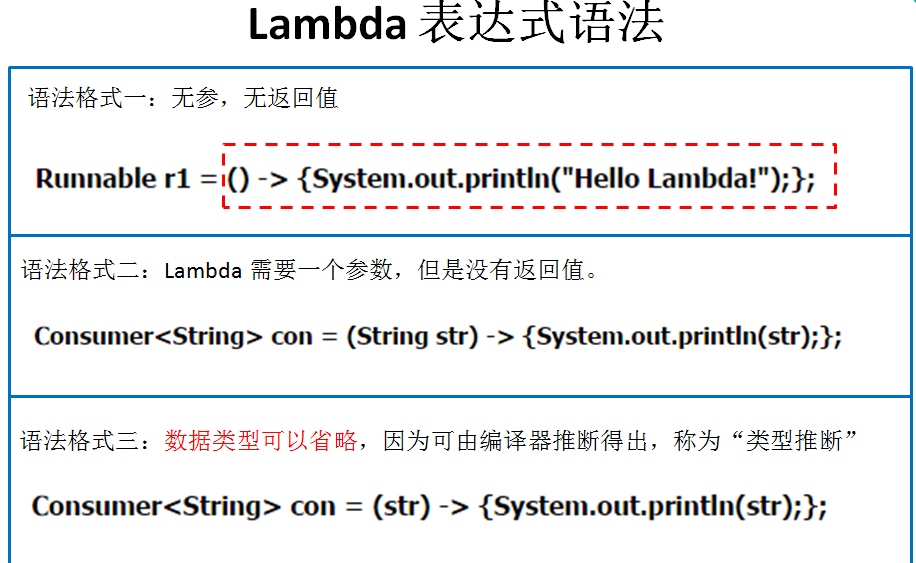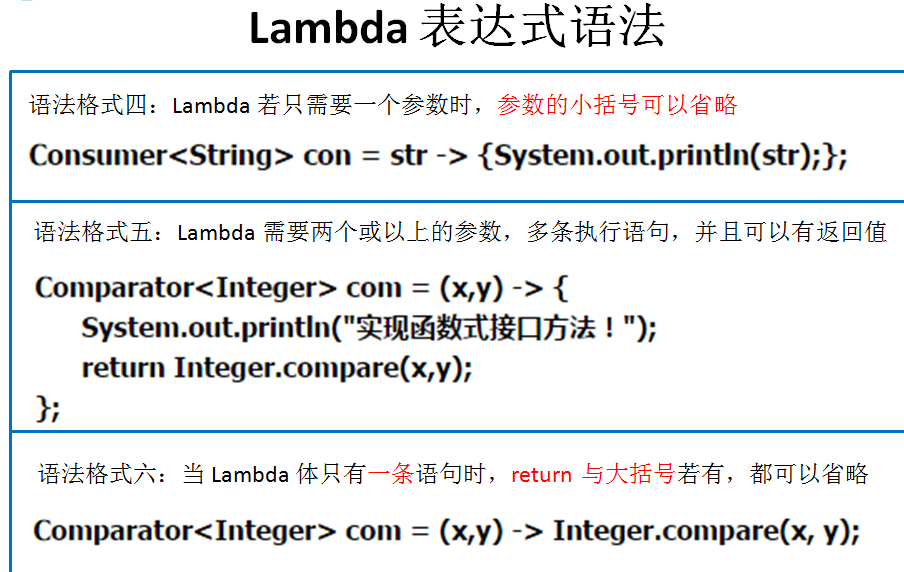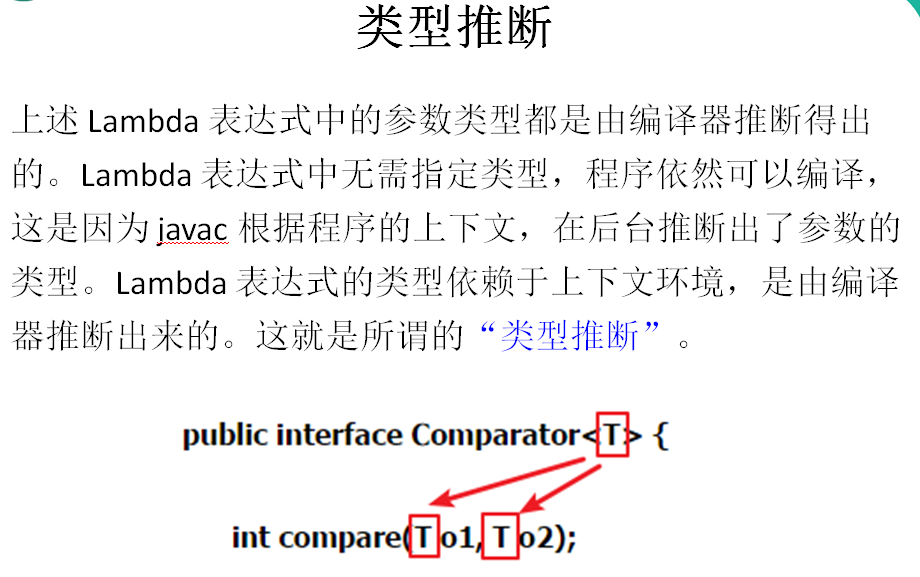java 的lambda表示式
阿新 • • 發佈:2019-05-11
為什麼使用 Lambda 表示式
lLambda 是一個匿名函式,我們可以把 Lambda 表示式理解為是一段可以傳遞的程式碼(將程式碼像資料一樣進行傳遞)。使用它可以寫出更簡潔、更靈活的程式碼。作為一種更緊湊的程式碼風格,使Java的語言表達能力得到了提升。
Lambda 表示式


Lambda 表示式語法
Lambda 表示式:在Java 8 語言中引入的一種新的語法元素和操作符。這個操作符為 “->” , 該操作符被稱為 Lambda 操作符或箭頭操作符。它將 Lambda 分為兩個部分:
左側:指定了 Lambda 表示式需要的參數
右側:指定了 Lambda 體,是抽象方法的實現邏輯,也即 Lambda 表示式要執行的功能。



package day26_1;
import org.junit.Test;
//寫一個介面 B , 其中有一個抽象方法 String upper(String string);
//使用匿名內部類的方式實現這個介面, 方法中把引數裡的字串變成大寫並返回
//使用lambda表示式方式實現這個介面, 方法中把引數裡的字串變成大寫並返回
interface B {
String upper(String string);
}
// 最常規的做法
class B2 implements B {
@Override
public String upper(String string) {
return string.toUpperCase();
}
}
/*
interface C {
Integer max(Integer n1, Integer n2); // 取最大值
}
*/
interface C<X extends Comparable> { // X在這裡就是泛型, 表示某種型別
X max(X n1, X n2); // 取兩個物件中的最大值
}
/*
* 寫一個介面 C , 定義抽象方法 Integer max(Integer n1, Integer n2);
*在測試方法中, 使用匿名內部類物件的方式完成這個介面的實現, 並呼叫方法, 列印輸出
*使用lambda表示式的方式來完成相同的功能
* */
public class LambdaExer {
@Test
public void test2() {
C<Integer> c = new C<Integer>() {
@Override
public Integer max(Integer n1, Integer n2) {
return n1 > n2 ? n1 : n2;
}
};
Integer max = c.max(10, 50);
System.out.println(max);
// lambda表示式 : 關注引數列表 -> 方法體
//C c2 = (Integer n1, Integer n2) -> {return n1 > n2 ? n1 : n2;};
C<String> c2 = (n1, n2) -> n1.compareTo(n2) > 0 ? n1 : n2; // 通用性最好
String max2 = c2.max("asfj", "ASFJ");
System.out.println(max2);
}
@Test
public void test1() {
B b1 = new B2();
String string1 = b1.upper("abcdefg");
System.out.println(string1);
// 匿名內部類
B b2 = new B() {// 類體
@Override
public String upper(String string) {
return string.toUpperCase();
}
};
String string2 = b2.upper("abcdefg");
System.out.println(string2);
// lambda表示式, 只關注 抽象方法引數列表 -> 方法體
B b3 = string -> string.toUpperCase();
String string3 = b3.upper("abcdefg");
System.out.println(string3);
}
}
package day26_1;
import java.util.Collections;
import java.util.Comparator;
import java.util.List;
import org.junit.Test;
/**
* lambda表示式 : 需要介面, 介面中必須只有一個抽象方法, 並且方法實現的方法體中只有一行語句.
* 語法 : 引數列表 -> 方法體
* lambda表示式本質上就是一個匿名內部類的物件, 並且型別只能是介面型別
*
* 主要用於代替匿名內部類物件
*/
@FunctionalInterface
interface A {
public String test(Integer num);
//public Integer test2(String num);
}
public class LambdaTest {
@Test
public void test3() {
A a1 = new A() {
@Override
public String test(Integer num) {
return String.valueOf(num);
}
};
// 引數型別可以省略, 並且, 如果引數列表中只有一個引數時, ()也省略
A a2 = num -> String.valueOf(num);
String string = a2.test(200);
System.out.println(string);
}
@Test
public void test2() {
List<Student> list = StudentData.getList();
// 比較器用於完成某兩個學生物件的比較
Comparator<Student> comparator = new Comparator<Student>() {
// 類體相當於介面的實現子類
@Override
public int compare(Student s1, Student s2) {
return (int)(s1.getScore() - s2.getScore());
}
};
Collections.sort(list,comparator);
for (Student student : list) {
System.out.println(student);
}
System.out.println("&&&&&&&&&&&&&&&&&&&&&&&&&&&&&&&&&&&&&");
// lambda表示式來做這個事情, 要求分數降序
// 如果我們的方法體中, 只有一行語句, 可以省略{}, 如果有return 也可以省略
//Comparator<Student> comparator2 = (Student s1, Student s2) -> {return (int)(s2.getScore() - s1.getScore());};
// 因為左邊的型別中已經有了泛型, 所有右面的表示式中的型別是可以推斷的, 那麼可以省略
//Comparator<Student> comparator2 = (Student s1, Student s2) -> (int)(s2.getScore() - s1.getScore());
Comparator<Student> comparator2 = (s1, s2) -> (int)(s2.getScore() - s1.getScore());
Collections.sort(list, comparator2);
for (Student student : list) {
System.out.println(student);
}
}
@Test
public void test1() {
Runnable r1 = new Runnable() {
@Override
public void run() {
System.out.println(Thread.currentThread().getName() + " : hello");
}
};
new Thread(r1).start();
// lambda表示式 : 省略父類或介面, 省略方法修飾符和返回值, 方法名, 只保留引數列表, 和 方法體
// lambda表示式本質上就是一個匿名內部類的物件
Runnable r2 = () -> System.out.println(Thread.currentThread().getName() + " : Hello2 ");
new Thread(r2).start()
